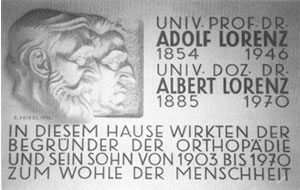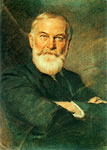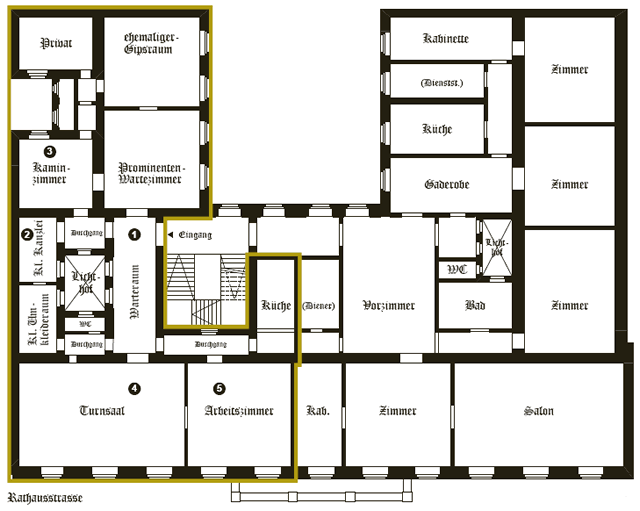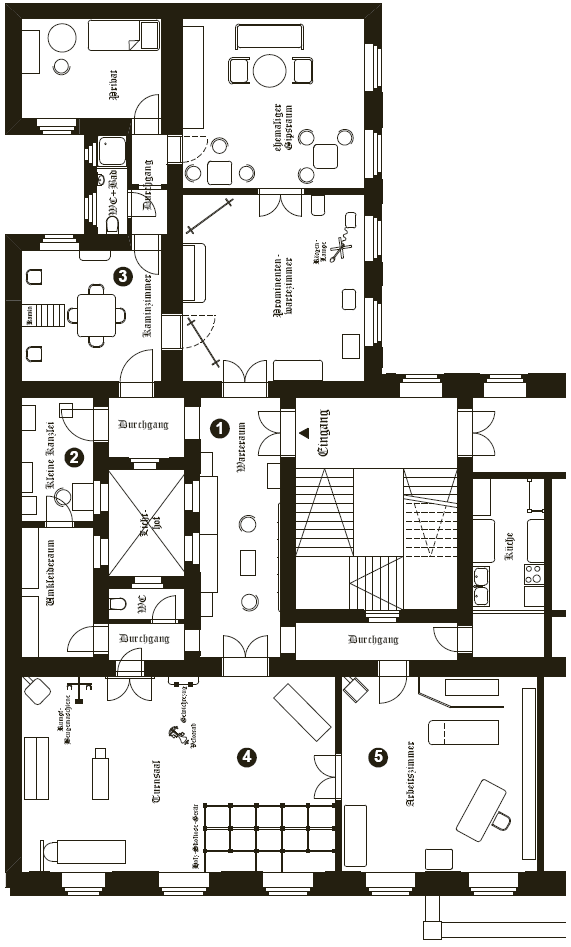| Vienna I., Rathausstrasse 21 |
| |
The building located at the back of the new university building
and at the border of the Votiv quarter was built in 1880 from a plan by
city architect Anton Adametz. Its style mirrored the expectations of the
contemporary upper middle-class. The owner of the four-story building was
Emanuel Prince Collalto et San Salvatore, military commander of Vienna and
principal of the corps headquarters. In 1918 the house was bought by Nettie
Kunitzer. In the thirties of the 20th century it changed hands
again and the present owner is the Allgemeine Unfallversicherungsanstalt
(AUVA), an insurance company.
 From
1903 Adolf Lorenz had his practice on the second floor at this address.
In the early years his name was already associated not only with the outpatient
clinic for orthopaedic surgery in the Vienna General Hospital - which he
used to call my most expensive hobbyi - but also with
his private practice. The vicinity of the university and the General Hospital
contributed to the development of an academic quarter, an area preferred
for living and working purposes by several other authorities of the Vienna
Medical School as well. The address Rathausstrasse 21 became a well-known
synonym for orthopaedics much like the address Berggasse 19 was for psychotherapy.
There Sigmund Freud had his consulting rooms after moving from his first
site in Rathausstrasse 7. Evidence of the international reputation of this
address for orthopaedic treatment is provided by the still existing voluminous
card index with medical histories. From
1903 Adolf Lorenz had his practice on the second floor at this address.
In the early years his name was already associated not only with the outpatient
clinic for orthopaedic surgery in the Vienna General Hospital - which he
used to call my most expensive hobbyi - but also with
his private practice. The vicinity of the university and the General Hospital
contributed to the development of an academic quarter, an area preferred
for living and working purposes by several other authorities of the Vienna
Medical School as well. The address Rathausstrasse 21 became a well-known
synonym for orthopaedics much like the address Berggasse 19 was for psychotherapy.
There Sigmund Freud had his consulting rooms after moving from his first
site in Rathausstrasse 7. Evidence of the international reputation of this
address for orthopaedic treatment is provided by the still existing voluminous
card index with medical histories.
On November 13, 1909 the Lorenz family has moved from Garnisongasse
3 to Rathausstrasse 21. Plans at the building control office show that in
the same year the practice was joined with the opposite appartment (no.
10). Consulting and private rooms comprised a total area of approximately
490 m2. In 1930 the family moved their permanent residence to
Altenberg and gave up the Viennese apartment. The consulting rooms with
a total area of 245 m2 remained. They consist of 4 large and
7 smaller rooms which have mostly been preserved in their original state.
In the 1920s the consulting rooms were used as a joint practice by
father and son. After Adolf Lorenz' death, his son, Albert, used the practice
without any alterations until shortly before his death in 1970. Afterwards
the Lorenz consulting rooms were used by his widow Helga (1910 - 1993) as
a curative sports institute until 1993.
The original sign of Prof. Lorenz and that of the later joint practice
(foyer) inevitably evoke in the visitor of this historic site a feeling
of the untiring work of these two famous orthopaedists.
On December 17, 1993 upon the initiative of
the Adolf-Lorenz-Society founded in 1992, a commemorative plaque designed
by the academic sculptor Prof. Rudolf Friedl and affixed to the facade of
the building at Rathausstrasse 21 was unveiled in a special ceremony.
| |
| For a tour of the consulting rooms the
following route is recommended: |
| |
| The tour starts in front of the entrance
door in the foyer (room 1). Passing through the short corridor one
reaches the small office (room 2). Afterwards one returns through
the corridor and turns left entering the fireplace room (room 3).
Back through the hallway and passing the large double door, one enters
the gymnastics room (room 4). Turning to the right one enters Lorenz'
study, the last stop on the tour. |
|

 From
1903 Adolf Lorenz had his practice on the second floor at this address.
In the early years his name was already associated not only with the outpatient
clinic for orthopaedic surgery in the Vienna General Hospital - which he
used to call my most expensive hobbyi - but also with
his private practice. The vicinity of the university and the General Hospital
contributed to the development of an academic quarter, an area preferred
for living and working purposes by several other authorities of the Vienna
Medical School as well. The address Rathausstrasse 21 became a well-known
synonym for orthopaedics much like the address Berggasse 19 was for psychotherapy.
There Sigmund Freud had his consulting rooms after moving from his first
site in Rathausstrasse 7. Evidence of the international reputation of this
address for orthopaedic treatment is provided by the still existing voluminous
card index with medical histories.
From
1903 Adolf Lorenz had his practice on the second floor at this address.
In the early years his name was already associated not only with the outpatient
clinic for orthopaedic surgery in the Vienna General Hospital - which he
used to call my most expensive hobbyi - but also with
his private practice. The vicinity of the university and the General Hospital
contributed to the development of an academic quarter, an area preferred
for living and working purposes by several other authorities of the Vienna
Medical School as well. The address Rathausstrasse 21 became a well-known
synonym for orthopaedics much like the address Berggasse 19 was for psychotherapy.
There Sigmund Freud had his consulting rooms after moving from his first
site in Rathausstrasse 7. Evidence of the international reputation of this
address for orthopaedic treatment is provided by the still existing voluminous
card index with medical histories.

